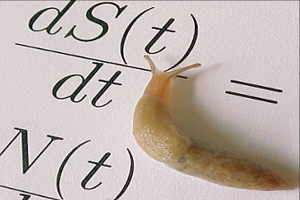- Digitalization of knowledge
- Human language technologies
- Bioinformatics
- Data mining
- Spatial data
- Mathematical modelling
Mathematical modelling
Modelling is a way of looking at real world problems and their possible solutions. We use it when it is not possible to conduct an experiment in real world or when it is economically unreasonable. Modelling is a consequence of human capability to think and imagine, to use language and symbols, to generalize and abstract.

A very big amount of data has been collected in the many years of experiments in different scientific fields. It is important to describe the observed system but it is equally important to understand and explain its mechanisms. Ideas on how those mechanisms work have to be formulated in such a way that it is possible to make predictions and then test those hypotheses.
In order to create a mathematical model, a mathematician has to work together with a scientist from the problem domain. They can make a new model or use an existing one (if any) with adaptation of parameters. In any case, we should not forget that models are just models - they simplify the framework in which an object being modeled exists or acts. This is very important to understand if we want to have a successful interpretation and use of models.

 Srpski
Srpski English
English